Our Environment | Term 3 Chapter 1 | 3rd Science - Questions with Answers | 3rd Science : Term 3 Unit 1 : Our Environment
Chapter: 3rd Science : Term 3 Unit 1 : Our Environment
Questions with Answers
Our Environment ( Term 3 Chapter 1 | 3rd Science)
EVALUATION
1. Which of these is an example for biotic factor?
a. Water
b. Goat
c. Air
Answer : b. Goat
2. Our environment is
surrounded by _______
a. biotic factors
b. abiotic factors
c. both biotic and abiotic factors
Answer : c. both biotic and abiotic factors
3. Human beings depend on _______ for their food.
a. plants
b. soil
c. wood
Answer : a.plants
4. ________are the primary producers.
a.
Non green plants
b.
Green plants
c.
Dry leaves
Answer : b. Green plants
5. Which is an example for decomposer?
a. Mango tree
b. Bacteria
c. Deer
Answer : b. Bacteria
6. Which of these
living things would die if there were no green plants on earth?
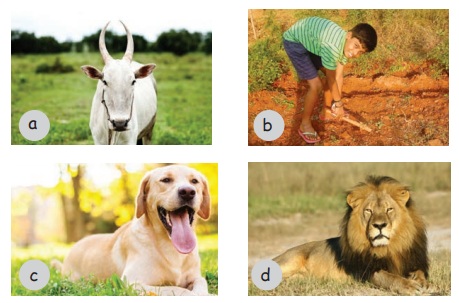
(a) a and c only
(b) b and d only
(c) d and a only
(d) a, b, c and d
Answer : (d) a, b, c
and d
II. Fill in the blanks.
1. Cow is a consumer. (Cow / Soil )
2. A young plant is known as sapling . ( tree / sapling )
3. Planting of sapling provides oxygen (oxygen / land )
4. World Environment Day is June 5th ( June 15th / June
5th )
5. Decomposers get food
from dead plants and animals. ( Decomposers / Producers ).
III. Match the following.
1. Stone - Consumer
2. Bacteria - Abiotic factor
3. Plants - Decomposer
4. Buffalo - Producers
Answer
1. Stone - Abiotic factor
2. Bacteria - Decomposer
3. Plants - Producers
4. Buffalo - Consumer
IV. Say true or false.
1. Abiotic
factors are important for biotic factors. (True)
2. River
is an example for biotic factor. (False)
3. ‘Van
Mahotsav’ is organised during the first week of July every year. (True)
4. Plants
are the consumers. (False)
5. Plants
provide food and shelter to living things. (True)
V. Answer the following.
1. Vijay placed two
things ‘P’ and ‘R’ (one living and one non-living) in separate cages with food
and water.

a. Which thing is likely to be a living thing? Give reason for
your answer.
P thing is likely to be living thing. Because the weight
increases from week 1 to week 4
b. What will be the weight of living thing in week 6?
12 kg
2. Write two examples for biotic and abiotic factors.
Biotic - Plants, Human beings
Abiotic - Water,
Sun
3. Write any three differences between living and non-living
things.

Living things
They can breathe and grow
They need food to live
They can feel
Non -living things
They cannot breathe and
They do not need food to live
They cannot feel
4. List the abiotic factors needed for insects.
Air, Soil
5. What are the biotic factors of a balanced ecosystem?
The biotic factors
of a balanced ecosystem are producers, consumers and decomposers.
6. Why plants are called primary producers?
Green plants make
their own food by the process of photosynthesis. Hence, they are called primary
producers.
7. Write any four benefits of plants.
i) Provide oxygen for breathing
ii) Provide food and shelter to living things
iii) Help in
bringing rainfall
iv) Offer a good
environment to live.
VI. Project
Make an album by collecting pictures of different kinds of biotic and abiotic factors.
Let Us Try
1. Write the names of the animals that you see in the previous page picture.
Cow Buffalo Goat
Rabit Monkey Turtle
2. Classify the following into natural things and man-made things.
(Dam, river, coconut tree, building, jasmine flower, hill, cloud, silver vessel, cell phone, temple, cake, air, sun, ship, water, pencil, book, doll, football, sunflower, crocodile, aeroplane)
Natural things: River, hill, cloud, air, sun, water, coconut tree, jasmine flower, sun flower, crocodile
Man-made things: Dam, building, silver vessel, cell phone, temple, cake, ship, pencil, book, doll, foot ball, aeroplane
Let Us Enjoy
Shall we mimic like the animals?
Crow, Cuckoo, Elephant, Parrot, Donkey, Cow, Goat, Dog
Let Us Connect
Match the following sources with their products and uses.

Let Us Try
1. Classify the following as Biotic / Abiotic factors.
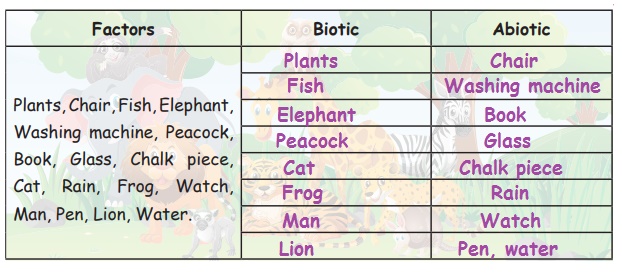
2. Think and Answer
a. A swing goes to and fro. Is it living or non-living?
Answer: non-living
b. We get wood from trees which are the living things. A chair is made from wood. Is the chair a living thing or a non-living thing?

Answer: non-living thing
Try to Answer
Look at the picture and answer the question.
Which of the non-living things can float?
a. Iron rod
b. Stone
c. Air filled ball
d. Coin
Answer: c. Air filled ball
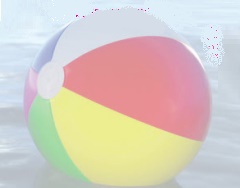
Let Us Try
The following statements describe some of the characteristics of living things. Identify and write the characteristic features using the given hints.
(Characteristics Hints: Move, Breathe, Feel, Needs Food, Grow, Reproduce)
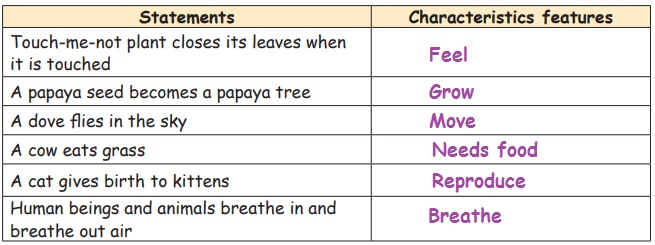
Let Us Play
Divide the class into two groups and ask the first group to write any five biotic factors and the second group to write any five abiotic factors seen around the school.
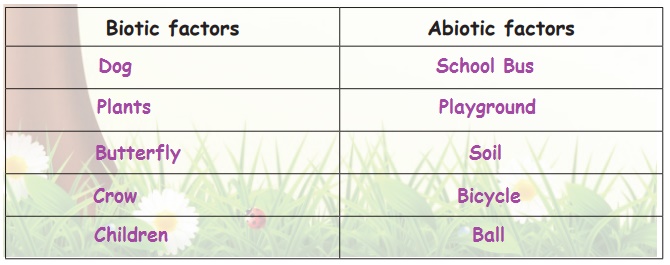
Write the needs of the following.
1. Birds : Air, Water, Sunlight, Insects, Trees
2. Insects : Soil, Air, Plants, Small creatures
3. Human beings: Air, Water, Plants, Sunlight, Animals.
Let Us Discuss
1. There is a large banyan tree in a park. Monkeys and birds have made the tree their home. Humans too spend time under the tree. Discuss with your friends, how the tree, monkeys, birds and humans are interdependent.
Birds and monkeys feed on the fruit. Birds build their nests in the tree. The tree gives shade to human beings when the day is hot. The wood of the tree is useful to human beings. The droppings of the birds are a manure to the tree. Birds play a vital role in dispersal of seeds. Thus the tree, monkeys, birds and human beings are interdependent.
2. Why is plant the most important living thing?
Because they make food from abiotic factors.
3. Discuss in a group and create an interlink of living and non-living factors.
Biotic and abiotic factors are linked to each other by the flow of energy through food.
Let Us Try
1. Write the abiotic factors needed for the following biotic factors to survive.
(Air, Water, Sunlight, Soil, Land, Wheat, Fruits, Grass, Hen)
a. Animals: Air, Water, Sunlight, Land, Grass
b. Plants: Air, Water, Sunlight, Soil
c. Human beings: Air, Water, Sunlight, Land, Wheat, Fruits, Hen
2. An animal that
a. flies in the air is: aerial
b. lives in water is: aquatic animals
c. moves on the ground is: Terrestrial animals
d. eats only plants is: Herbivores
Let Us Try
Classify the following biotic factors.
(Tulsi, Fungi, Mango tree, Rabbit, Eagle, Cat, Dog, Cucumber plant, Human, Grass, Crocodile, Crow, Bacteria)
Producers : Tulsi, Mango tree, Cucumber plant, Grass
Consumers : Rabbit, Eagle, Cat, Dog, Human, Crocodile, Crow
Decomposers : Fungi. Bacteria
Let Us Discuss
1. Let us discuss and write.
Plants and human beings are living things. Why do human beings depend on plants?
Human beings obtain food from plants and oxygen for respiration. So they depend on plants.
2. Divide the students into three groups and give them some pictures of living things. Ask them to classify the pictures based on their food habits.
3. Take your students outside the classroom or to a park. Ask them to note down the producers and consumers they could identify there.
Let Us Try
The names of several natural resources are hidden in the box below. Find as many as possible. Some words are repeated.
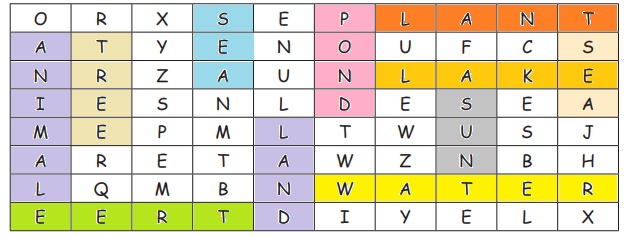
Let us Connect
Link the animals as herbivores, carnivores and omnivores.
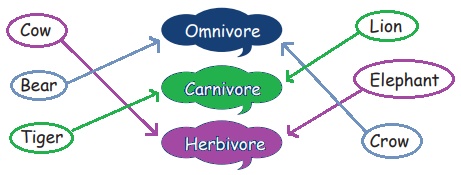
Let Us Do
A. Write any two uses of trees.
1. Help in bringing rainfall
2. Provide oxygen
B. Conduct an awareness campaign on ‘Save Our Environment’.
C. Plant saplings in your school campus.
D. Preparation of seed ball
Take some clay, humus, add water and mix well. After mixing, place the available seeds inside them and make a seed ball. Then dry and keep it safe. Distribute the seed balls to public on special occasions of your school.
E. Write some slogans on ‘Save Plants’ and paste them on the tree in your school campus/road sides. (E.g., Take care of the Earth and it will take care of you. It’s not yours, nor mine, it’s ours)
1. Trees look fair, they clean the air.
2. Forests are our wealth. They preserve our health.
The nature of our future depends on the future of our nature.
Related Topics